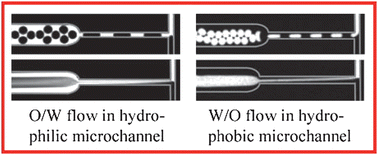In microfluidic systems, interfacial tension plays a predominant role in determining the two-phase flow behavior due to the high surface area to volume ratio. We investigated the influence of both solid–liquid (σSL) and liquid–liquid (σLL) interfacial tensions on water–oil two-phase flows in microfluidic devices. Experimental results show that, unlike macroscopic systems, σSL plays a dominant role, determining the emulsion type created in microchannels: oil-in-water (O/W) flow in hydrophilic microchannels and water-in-oil (W/O) flow in the corresponding hydrophobically treated microchannels. Modification of σLL by surfactants only plays a secondary role. By tuning σLL, oil–water two-phase flow patterns could be changed from droplet-based to stratified flows under constant flow conditions in the same device. In addition, also droplet deformation, coalescence and emulsion inversion could be achieved by tailoring σSL and σLL in microfluidic devices. Microfluidic technology therefore provides a valuable additional tool for quantitatively manipulating and evaluating these phenomena which are difficult to realize in the macroscale devices.

You have access to this article
 Please wait while we load your content...
Something went wrong. Try again?
Please wait while we load your content...
Something went wrong. Try again?


 Please wait while we load your content...
Please wait while we load your content...